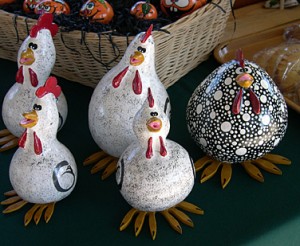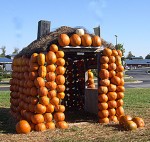 A visit to the local farmers’ market or local pumpkin patch in the fall reveals a big selection of pumpkins for sale. The selection is also varied so whether you want an ornamental pumpkin for holiday decorations or one for making pies, muffins, soup, or other goodies you, should be able to find what you want. But always remember, the “pumpkins” you see are not all really pumpkins; some are squash and many are gourds.
A visit to the local farmers’ market or local pumpkin patch in the fall reveals a big selection of pumpkins for sale. The selection is also varied so whether you want an ornamental pumpkin for holiday decorations or one for making pies, muffins, soup, or other goodies you, should be able to find what you want. But always remember, the “pumpkins” you see are not all really pumpkins; some are squash and many are gourds.
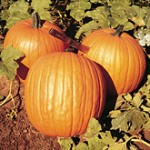
The biggest and most important differences between ornamental pumpkins and culinary pumpkins regard water content and sugar content. Ornamental pumpkins contain more water and less sugar than culinary pumpkins. Both can be used for cooking and eating, but the decorative pumpkins will require more sugar and longer cooking time to compensate for these chemical differences. In addition, the appearance of the pumpkins may be different; ornamental pumpkins are usually an attractive orange color while many of the culinary pumpkins are tan.
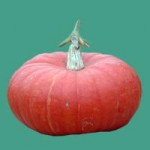
When choosing a culinary pumpkin, availability will probably be the most limiting factor so you will not have a huge choice. Small pumpkins good for cooking include ‘Small Sugar’ and ‘Winter Luxury’. ‘Small Sugar’ has attractive orange color, and dense, dry, stringless flesh while ‘Winter luxury’ has a white net over its orange skin, and smooth, silky flesh. Larger cultivars good for cooking include ‘Cheese’, ‘Golden Cushaw’, and ‘Cinderella’. ‘Cinderella’ has an advantage of being very attractive with its orange red skin and Cinderella-carriage shape. You can calculate the size of the pumpkin to buy by considering that one pound of raw, untrimmed pumpkin will yield one cup finished pumpkin puree.
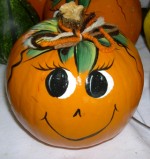
When buying ornamental pumpkins you have many more options to consider. First, consider how you plan to use the pumpkin; jack o lantern, painted, just the way it comes off the vine. The use may influence what pumpkin will best meet your expectations. Ornamental pumpkins come in a variety of sizes, shapes, colors. Pumpkins may be as small as a few ounces or over 1700 pounds with most falling in the 10-20 pound range. They can be round, or tall and oval. Although orange is the most common color, red , white, and bluish-green are possible. Ornamental pumpkins also vary in texture so if you plan to paint the pumpkin, pick one that is smooth and not heavily ribbed.

Regardless of what kind of pumpkin you buy make sure that you have a good one that is not rotting. The skin should be bruise free; especially check the bottom of the pumpkin where animal pests may have attacked and pierced the skin letting in bacteria that will rot the flesh. Shake the pumpkin and if you hear anything sloshing inside, don’t buy it; it is probably already rotting. Make sure that it has a healthy looking stem because a damaged stem area is another place where bacteria may enter. Lopsided or rolling will not matter for a culinary pumpkin but could be a problem for an ornamental one

“What about all those oddly shaped and colored pumpkins?” you ask. They are probably gourds. They are very similar to pumpkins but are not edible and many can be dried for long-term use. Some have warts but many are smooth. They, too, make wonderful fall holiday decorations and are usually used as they come from the vine, with a coat of preservative on them to make them shiny, or painted. Check for bruises and signs of decay just as you would do when buying a pumpkin (but dry material rattling inside is OK).
A visit to a pumpkin patch or farmers’ market to look at all the wonderful choices, is one of my favorite fall activities. I am always inspired to grow some in my vegetable garden and have even saved seeds from my favorite pumpkins and gourds so I can have them again next year. Saving seed does not seem to work as they are hybrids and don’t come true. Besides, if I grow them I don’t have a good excuse for a visit to the pumpkin patch.
